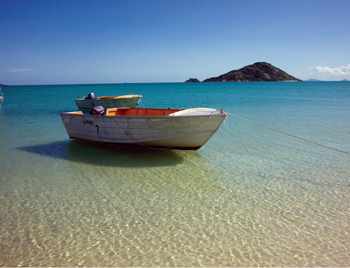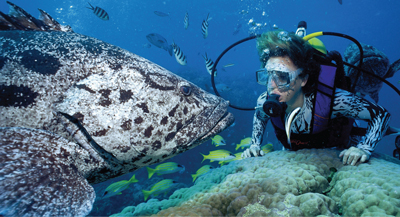The Great Barrier Reef is an enormous puzzle of Van Gogh greens, aquas and blues, miles upon miles of complex coral formations that make up Earth’s largest living structure of organisms. It includes more than 900 islands and 2,900 reefs scattered off the Queensland coast along the continental shelf. Visible from space, the expanse covers more than 133,000 square miles.
The reef is an ever-growing life-form, with billions of “polyps” painting the coral its bright colors. When these die, their skeletons whiten and become part of a growing architectural project that never ends. The biodiversity of the reef’s ecosystem is greater than anywhere else on the planet, including the teeming equatorial rain forests. More than 400 types of coral, 1,500 sponges, 30 species of marine mammals and 4,000 varieties of clams live here, and scientists are monitoring the impact of climate change, land-based pollutants, tourism and overfishing on the reef’s natural balance. Rising ocean temperatures are a threat to its survival.
Scuba divers and snorkelers are drawn year-round to this dazzling marine spectacle. Snorkeling above giant clams, you can see their scallop-edged shells open slowly and their mouths stretch wide to take in food. With an average life span of 100 years, some grow as wide as four feet and weigh as much as 500 pounds. You can encounter loggerhead turtles, dolphins and sea cows called dugongs. Humpback whales migrate to the reef from Antarctica and breed between May and October. Divers come face to face among the coral’s deep reds and yellows with giant potato cod, barracudas, manta rays, sweetlip emperors and more than 1,500 other fish species.
Several resort areas offer day trips and sails to prime dive locations. A flotilla of cruise boats,  catamarans, glass-bottom boats and yachts heads out daily from Hamilton Island, Cairns and Airlie Beach.
catamarans, glass-bottom boats and yachts heads out daily from Hamilton Island, Cairns and Airlie Beach.
Seaplane or helicopter flights are popular for visiting the Whitsunday island group, 74 in all, where shifting tides move sand and water to create a fusion of swirling color. Near Hardy’s Reef, look for an iconic reef view: the formation of a heart, so small it could be missed unless pilots point it out. Day flights land on beautiful Whitehaven Beach and often include a champagne lunch. Powder-white sand and tranquil surf make for easy swimming and snorkeling from the beach. More adventurous travelers seeking greater seclusion can book a sea kayak or jet boat to explore coves like scenic Hill Inlet at Whitehaven’s northern end.
Another pristine island is Lizard, rustic and undeveloped, an alternative to the tourist-centric resorts. Aboriginal people regarded this as a sacred place, and it’s a protected national park, with more than 20 beaches and a fringe reef for snorkeling and diving. The island is named for its large lizards, Gould’s monitors, which belong to the same family as Indonesia’s Komodo dragons and reach a length of up to three feet. Walk along the island’s quiet paths and you’re bound to see a few watching you in perfect stillness, the only movement a lightning-fast tongue, a surprising flash of deep purple.
Lizard has accommodations at two extremes: camping facilities at the northern end of Watson’s Bay, and the five-star Lizard Island Resort, with 40 bungalows overlooking the ocean, a plunge pool just off the beach, and a spa. The Osprey restaurant has excellent fresh seafood entrées; a local crustacean called Moreton Bay bugs, aka Bay lobster, is worth a try when it’s in season. Resort guests can also book private dinghies, complete with picnic lunch, to explore surrounding coves.
The highest point on the island can be reached by a steep, rocky hike up 360 meters that takes about three hours round-trip. From the summit, called Cook’s Look, Ca ptain James Cook was able to chart his course through the maze of reefs out to sea.
ptain James Cook was able to chart his course through the maze of reefs out to sea.
Fitzroy Island, also a national park, is accessible by boat from Cairns. A large tourist resort, recently redeveloped, has accommodations ranging from dormitory style to luxury apartments. Nudey Beach—not a nude beach—is a popular swim and snorkel spot along a granite-boulder shore.
Lady Elliot Island is a true coral cay at the southernmost end of the reef’s islands. Resting on a tidal lagoon, it’s surrounded by a reef of living coral. The three-star Lady Elliot Eco-Resort is designed to minimize impact on the environment.
If you go
Accommodations
Lizard Island Resort
Tel: +011 61 7 4043 1999
Reef View Hotel
Hamilton Island Resort
Qualia
Hamilton Island
Tel: +011 61 2 9433 3349
E-mail: [email protected]
Fitzroy Island Hunt Resort
E-mail: [email protected]
Flights
Quantas flies to Brisbane daily from LAX,
Reservations Tel: 1 800 227 4500
Interisland
flights & charters
Hinterland Aviation charter flight
Tel: +011 61 7 4035 9323
Virgin Blue
Tel: +011 61 7 3295 2296
Seaplane tours
Aviation Tourism Australia
Tel: +011 61 7 4946 8249
E-mail: [email protected]


